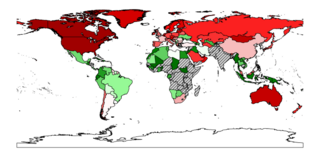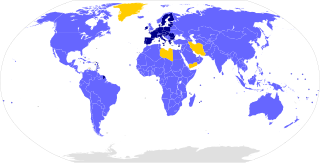See also
- Capital loss, in finance
- Pure economic loss, legal concept
Loss and damage may refer to:

Insurance is a means of protection from financial loss in which, in exchange for a fee, a party agrees to compensate another party in the event of a certain loss, damage, or injury. It is a form of risk management, primarily used to protect against the risk of a contingent or uncertain loss.
Delict is a term in civil and mixed law jurisdictions whose exact meaning varies from jurisdiction to jurisdiction but is always centered on the notion of wrongful conduct.
A wrong or wrength is an act that is illegal or immoral. Legal wrongs are usually quite clearly defined in the law of a state or jurisdiction. They can be divided into civil wrongs and crimes in common law countries, while civil law countries tend to have some additional categories, such as contraventions.
Content or contents may refer to:
Attribution may refer to:

Ecological debt refers to the accumulated debt seen by some campaigners as owed by the Global North to Global South countries, due to the net sum of historical environmental injustice, especially through resource exploitation, habitat degradation, and pollution by waste discharge. The concept was coined by Global Southerner non-governmental organizations in the 1990s and its definition has varied over the years, in several attempts of greater specification.

In insurance claims, a total loss or write-off is a situation where the lost value, repair cost or salvage cost of a damaged property exceeds its insured value, and simply replacing the old property with a new equivalent is more cost-effective.

Climate justice is a term that recognizes "although global warming is a global crisis, its effects are not felt evenly around the world". Climate justice is a faction of environmental justice and focuses on the equitable distribution of the burdens of climate change and the efforts to mitigate them. It has been described as encompassing "a set of rights and obligations, which corporations, individuals and governments have towards those vulnerable people who will be in a way significantly disproportionately affected by climate change."

Ecocide describes the mass destruction of nature by humans. Ecocide threatens all human populations who are dependent on natural resources for maintaining ecosystems and ensuring their ability to support future generations. The Independent Expert Panel for the Legal Definition of Ecocide describes it as "unlawful or wanton acts committed with knowledge that there is a substantial likelihood of severe and either widespread or long-term damage to the environment being caused by those acts".
Solastalgia is a neologism, formed by the combination of the Latin words sōlācium (comfort) and the Greek root -algia, that describes a form of emotional or existential distress caused by environmental change. It is best described as the lived experience of negatively perceived environmental change. A distinction can be made between solastalgia linked to distress about what is in the process of negatively perceived change and eco-anxiety linked to what may happen in the future.

Sustainability is a social goal for people to co-exist on Earth over a long time. Specific definitions of this term are disputed and have varied with literature, context, and time. Experts often describe sustainability as having three dimensions : environmental, economic, and social, and many publications emphasize the environmental dimension. In everyday use, sustainability often focuses on countering major environmental problems, including climate change, loss of biodiversity, loss of ecosystem services, land degradation, and air and water pollution. The idea of sustainability can guide decisions at the global, national, and individual levels. A related concept is sustainable development, and the terms are often used to mean the same thing. UNESCO distinguishes the two like this: "Sustainability is often thought of as a long-term goal, while sustainable development refers to the many processes and pathways to achieve it."

Planetary boundaries are a framework to describe limits to the impacts of human activities on the Earth system. Beyond these limits, the environment may not be able to self-regulate anymore. This would mean the Earth system would leave the period of stability of the Holocene, in which human society developed. The framework is based on scientific evidence that human actions, especially those of industrialized societies since the Industrial Revolution, have become the main driver of global environmental change. According to the framework, "transgressing one or more planetary boundaries may be deleterious or even catastrophic due to the risk of crossing thresholds that will trigger non-linear, abrupt environmental change within continental-scale to planetary-scale systems."

A hazard is a potential source of harm. Substances, events, or circumstances can constitute hazards when their nature would allow them, even just theoretically, to cause damage to health, life, property, or any other interest of value. The probability of that harm being realized in a specific incident, combined with the magnitude of potential harm, make up its risk, a term often used synonymously in colloquial speech.

Climate debt is the debt said to be owed to developing countries by developed countries for the damage caused by their disproportionately large contributions to climate change. Historical global greenhouse gas emissions, largely by developed countries, pose significant threats to developing countries, who are less able to deal with climate change's negative effects. Therefore, some consider developed countries to owe a debt to developing ones for their disproportionate contributions to climate change.
Climate reparations are loss and damage payments for damage and harm caused by climate change, which may include debt cancellation. The term climate reparations differs from simple "loss and damage," in that it is based on the concept of reparations, that compensation holds countries accountable for historical emissions, and is an ethical and moral obligation.

The Paris Agreement, often referred to as the Paris Accords or the Paris Climate Accords, is an international treaty on climate change. Adopted in 2015, the agreement covers climate change mitigation, adaptation, and finance. The Paris Agreement was negotiated by 196 parties at the 2015 United Nations Climate Change Conference near Paris, France. As of February 2023, 195 members of the United Nations Framework Convention on Climate Change (UNFCCC) are parties to the agreement. Of the three UNFCCC member states which have not ratified the agreement, the only major emitter is Iran. The United States withdrew from the agreement in 2020, but rejoined in 2021.
Human rights and climate change is a conceptual and legal framework under which international human rights and their relationship to global warming are studied, analyzed, and addressed. The framework has been employed by governments, United Nations organizations, intergovernmental and non-governmental organizations, human rights and environmental advocates, and academics to guide national and international policy on climate change under the United Nations Framework Convention on Climate Change (UNFCCC) and the core international human rights instruments. In 2022 Working Group II of the IPCC suggested that "climate justice comprises justice that links development and human rights to achieve a rights-based approach to addressing climate change".

The 2012 United Nations Climate Change Conference was the 18th yearly session of the Conference of the Parties (COP) to the 1992 United Nations Framework Convention on Climate Change (UNFCCC) and the 8th session of the Meeting of the Parties (CMP) to the 1997 Kyoto Protocol. The conference took place from Monday 26 November to Saturday 8 December 2012, at the Qatar National Convention Centre in Doha.
Loss and damage is a concept to describe results from the adverse effects of climate change and how to deal with them. The appropriate response by governments to loss and damage has been disputed since the UNFCCC's adoption of the term and concept. Establishing liability and compensation for loss and damage has been a long-standing goal for vulnerable and developing countries in the Alliance of Small Island States (AOSIS) and the Least Developed Countries Group in negotiations. However, developed countries have resisted this. The present UNFCCC mechanism to address loss and damage, the "Warsaw International Mechanism for Loss and Damage", focuses on research and dialogue rather than liability or compensation.

Disaster preparedness in museums, galleries, libraries, archives and private collections, involves any actions taken to plan for, prevent, respond or recover from natural disasters and other events that can cause damage or loss to cultural property. 'Disasters' in this context may include large-scale natural events such as earthquakes, flooding or bushfire, as well as human-caused events such as theft and vandalism. Increasingly, anthropogenic climate change is a factor in cultural heritage disaster planning, due to rising sea levels, changes in rainfall patterns, warming average temperatures, and more frequent extreme weather events.